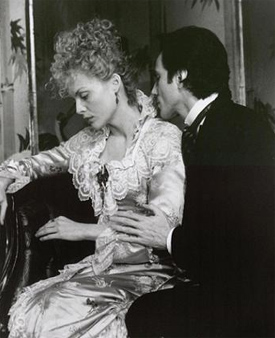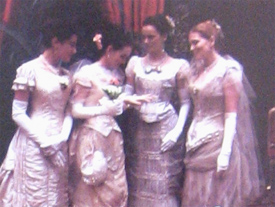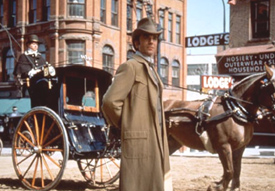PRODUCERS // "THE AGE OF INNOCENCE" (1992) |
Recreating The Gilded Age |  |
|
Martin Scorsese's opulent period piece represented not only an artistic challenge for him but a logistical challenge for the production staff. In the spring of 1992, towards the end of the shoot (which had extended from Brooklyn, Queens and Philadelphia to the upstate city of Troy, New York — and which would later go on to Paris), De Fina spoke from her Midtown production office about the rigors of filming Warton's refined tale.
Morgan: How is the shoot going so far?
How is it compared to what you may have anticipated? Anything this big and complex, we went in knowing it was going to be difficult. I think we were pretty well-prepared; we had done a lot of work budgeting and scouting before, when the picture was at 20th, and (rightly so) they were concerned. And now we're at Columbia, but everyone of course is concerned when you try to do something like this about how much it's going to really cost, especially more so in this atmosphere, but always, everyone's concerned that you're going to start with one budget and wind up spending twice as much. So we've done a lot of research and a lot of scouting and budgeting. I think we had a good idea about what we were getting into, but there was a point just before we'd started where it all sort of hit, everyone said, 'My God, this is really, really immense!' And we got a production manager whom I'd worked with before, Bruce Pustin; he's done BILLY BATHGATE, his background was in first TV and then features doing big period pictures. So he was key, because I felt we needed someone like that [who had] been through it. Every movie I've done there's one major sequence or one major set, and this one it's like every three weeks there's another major sequence, or another major set, it's like it never stops. But the actors are great, it looks great, so we're having a good time. There's a lot of reward at the end of the day. Are the days longer than usual? I think it's longer for the actors, especially the women, because of the hairdressing and the costuming. You don't just come in and spend an hour, because they have the hair pieces, the wigs, the makeup, they're made up but it can't look like makeup, and then the dresses, you know they can't sit in some of those dresses, so I think it must be very difficult for them, very long. How did you decide upon shooting exteriors in Troy, New York? And what assistance did you receive from local or state film commissions?
Did you consider shooting exteriors in New York City, such as in Greenwich Village, the Washington Square Park area? We investigated it slightly — and there are some interiors here — but it's almost impossible to find more than maybe one or two brownstones that you can really use, and [then] you've got a lot of things to change [and] there's tough traffic noise and congestion. So that's why Troy worked out so well — it was not only period correct, but it was quiet. I mean, every noise that we're so used to is wrong for the 1870s. I was talking to the Sound Editor and he was saying, other than fireplace ashes and horses, what sounds were there, you know? There were no telephones, no radios, no cars, no airplanes, so it must have been very quiet. So that was a big consideration, and that was one of the reasons why Troy worked out so well, because it is a very quiet town. I mean, we did do some interiors in Brooklyn Heights, and we're now in Park Slope. We're doing a lot of interior work in the city, but we really couldn't find any exteriors. And especially Manhattan, it was difficult to find places that were quiet enough, even for interiors. We did use a building at 68th and Park, the Americas Society, which is a beautiful building; we did a big dinner scene there. But we did get a lot of cooperation from the Police Dept and the Mayor's Office so that we could quiet the traffic a little bit; I mean obviously we didn't close Park Avenue. How is the crew responding to working on a period picture? Once you actually go in a set, there is a different atmosphere. I can't tell you how much time we spent having fireplaces cleaned and fixed and opened, and it's very different when you walk in and there's all of this very heavy tapestry, and fires in the fireplace, heavy molding — everyone on the crew sort of gets to be a part of that feeling and really understands it, I think as we're progressing they are. [We're working] among very fragile things, a lot of antiques, glass, and china. I imagine the insurance costs are considerable. Yes! At first we were really scared, and we've sort of gotten over it, but these things are not just expensive but also in some cases irreplaceable, or even if they're replaceable they're very rare. We have to be very sensitive just handling everything and that includes everyone including the grips, because they have to work around these things, so we've had some lessons. We had somebody who was in charge of manners, just manners, [because] everything was different, the way people ate, the way people sat, the way they walked in the door and tipped their hat, cause people wore hats, it's all so different, and I think as we go along we're getting more and more sensitive to what the period was like. How long were you at Troy? We shot for three, three-and-a-half weeks. It worked out really well. It's a city where they've had a few movies, actually SCENT OF A WOMAN was shooting in the area, but not downtown where we were. They were very cooperative, we did a lot of big snow scenes, we closed streets, we put in dirt and snow, took out air conditioners and lamp posts and all the usual stuff, it worked out really well, though. The people in the city had at some point I guess decided to really preserve everything, and they buried all the overhead wires, and there wasn't that much work to do, it would have been impossible to do those scenes in New York City, for example, even in Brooklyn. People were very cooperative, and enjoyed having us film, and we used local extras, which is always helpful for the community, and we spent a lot of money there, and the people in the Town Hall especially from the day we arrived couldn't have been more helpful and happy to see us. I think we really enjoyed it, a lot of people were sorry to leave. It's a real town, it's not just some houses and a shopping mall — very interesting architecture and restaurants, and an opera house. There were a lot of people sorry to have to go. What are the film's below-the line costs? I don't know if I'm supposed to talk about that. All together it's a little over thirty. The actors and everyone above the line did take cuts, because we had always said it's an expensive movie, we can't lie about that, and we have to do it right. The project really deserved to be done correctly. So a lot of people took major cuts, because no one's looking to get rich [on this].
Postscript: THE AGE OF INNOCENCE's U.S. domestic gross was approximately $32 million.
| |||||||||
copyright 1992, 2009 by David Morgan
All rights reserved.








 De Fina: It's going really well. It's very hard to do a period movie, but some of the things have worked out miraculously well. Actually we've got some really good people working with us. The costumes are incredible, I want them, you know? They look very uncomfortable, though, but they're beautiful fabrics. It's been really a lot of fun — a lot of work, but a lot of fun.
De Fina: It's going really well. It's very hard to do a period movie, but some of the things have worked out miraculously well. Actually we've got some really good people working with us. The costumes are incredible, I want them, you know? They look very uncomfortable, though, but they're beautiful fabrics. It's been really a lot of fun — a lot of work, but a lot of fun.
 Obviously New York State wanted us, and we wanted to be here
because we live here. And actually it should take place here, it was written
in New York for New York, and so they worked incredibly hard, especially
the state office, as well as the city, but the state office did a lot of
scouting for us.
Obviously New York State wanted us, and we wanted to be here
because we live here. And actually it should take place here, it was written
in New York for New York, and so they worked incredibly hard, especially
the state office, as well as the city, but the state office did a lot of
scouting for us.
